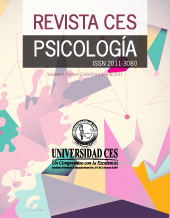Psychometric Properties of the Spouse Specific Dependency Scale for Women (SSDS-W)
DOI:
https://doi.org/10.21615/cesp.5417Keywords:
Spouse Specific Dependency Scale for Women (SSDS-W), dependency spouse, emotional dependency, hierarchical model, Item Response Theory (IRT)Abstract
The aim of this research was to adapt and validate the Spouse Specific Dependency Scale for Women (SSDS-W) for use in the Brazilian context, which consists of 30 items. In study 1, 347 women participated. It was obtained a three- dimensional structure: anxiety attachment (α = .88), emotional dependence (α = .80) and exclusive dependence (α = .72), with satisfactory internal consistencies. In the second study, 325 women participated, and three structural equation models were tested. The results indicated that the EDEC-M presented better index adjustment in the second-order hierarchical model: χ2 /df = 1.89; CFI = .95; TLI = .95; GFI = .95; RMSEA .05 and SRMR = .07. This model was supported by Item Response Theory (IRT), which analyzed a satisfactory variation of the item difficulty and allowed the construction of an Item Map for the measure. Therefore, the EDEC-M presented satisfactory psychometric properties evidence of construct validity for the Brazilian context in women.
Downloads
References
Abuín, M. R., & de Rivera, L. (2015). Dependency, detachment and psychopathology in a Non clinical sample: General relations and gender differences. Is there a new line of inquiry on paranoid pathology? Clínica y Salud, 26(2), 65–72. http://dx.doi:10.1016/j.clysa.2015.06.003
Beck, A. T., Epstein, N., Harrison, R. P., & Emery, G. (1983). Development of the Sociotropy-Autonomy Scale: A measure of personality factors in psychopathology. Unpublished manuscript, University of Pennsylvania, Philadelphia.
Blatt, S. J., D'Afflitti, J. P., & Quinlan, D. M. (1976). Experiences of depression in normal young adults. Journal of Abnormal Psychology, 85(4), 383-389. https://doi.org/10.1037/0021-843X.85.4.383
Bond, T. G., & Fox, C. M. (2001). Applying the Rasch model: fundamental measurement in the human sciences. London: Lawrence Erlbaum Associates.
Bornstein, R. F. (2005). The dependent patient: A practitioner’s guide. Washington, DC: American Psychological Association.
Bornstein, R. F. (2006). The complex relationship between dependency and domestic violence: Converging psychological factors and social forces. American Psychologist, 61(6), 595-606. http://dx.doi.org/10.1037/0003-066X.61.6.595
Bornstein, R. F. (2012). Illuminating a neglected clinical issue: Societal costs of interpersonal dependency and dependent personality disorder. Journal of clinical psychology, 68(7), 766-781. http://dx.doi:10.1002/jclp.21870
Bornstein, R. F., Geiselman, K. J., Eisenhart, E. A., & Languirand, M. A. (2002). Construct validity of the relationship profile test. Assessment, 9(4), 373–381. http://dx.doi:10.1177/1073191102238195
Bornstein, R. F., Porcerelli, J. H., Huprich, S. K., & Markova, T. (2009). Construct validity of the relationship profile test: correlates of overdependence, detachment, and healthy dependency in low Income urban women seeking medical services. Journal of Personality Assessment, 91(6), 537–544. http://dx.doi:10.1080/00223890903228406
Borsa, J. C., Damásio, B. F., & Bandeira, D. R. (2012). Adaptação e validação de instrumentos psicológicos entre culturas: algumas considerações. Paidéia, 22(53), 423-432.
Bowlby, J. (1973). Separation. Basic Books, London.
Broozi, A., & Fraghdani, A. (2018). The effect of spouse-specific dependency on entrapment and couple burnout in married students. Semi-annual Journal of Family Pathology, Counseling and Enrichment, 3(2), 1-20.
Bution, D. C., & Wechsler, A. M. (2016). Dependência emocional: uma revisão sistemática da literatura. Estudos Interdisciplinares em Psicologia, 7(1), 77-101.
Castelló, J. (2005). Dependência emocional: características e tratamento. Espanha: Aliança Editorial.
Comrey, A. L. (1988). Factor-analytic methods of scale development in personality and clinical psychology. Journal of Consulting and Clinical Psychology, 56(5), 754-761. http://dx.doi:10.1037/0022-006X.56.5.754
Deza, S. (2012). Por que as mulheres permanecem em relacionamentos violentos? Avanços em Psicologia, 20(1), 45-55.
Estévez, A., Urbiola, I., Iruarrizaga, I., & Onaindia, J. (2017). Emotional dependency in dating relationships and psychological consequences of internet and mobile abuse. Anales de psicología, 33(2), 260.
González-Jiménez, A. J., & Hernández-Romera, M. del M. (2014). Emotional dependency based on the gender of young adolescents in Almeria, Spain. Procedia - Social and Behavioral Sciences, 132, 527–532. http://dx.doi:10.1016/j.sbspro.2014.04.348
Greenwald, A. G., McGhee, D. E., & Schwartz, J. L. K. (1998). Measuring individual differences in implicit cognition: the implicit association test. Journal of Personality and Soclal Psychology, 74(6), 1464-1480.
Haggerty, G., Bornstein, R. F., Khalid, M., Sharma, V., Riaz, U., Blanchard, M., … Sinclair, S. J. (2015). Construct Validity of the Relationship Profile Test: Links with Measures of Psychopathology and Adult Attachment. Journal of Personality Assessment, 98(1), 82–87. http://dx.doi:10.1080/00223891.2015.1110824
Hair, J. F., Black, W. C., Babin, B. J., Anderson, R. E., & Tatham, R. L. (2009). Análise multivariada dos dados (6a ed.). Porto Alegre: Bookman.
Harvey, R., & Hammer, A. (1999). Item response theory. The Counseling Psychologist, 27, 353- 383.
Hasan, M., & Clark, E. M. (2017). I get so lonely, baby: the effects of loneliness and social isolation on romantic dependency. The Journal of social psychology, 157(4), 429-444.
Hirschfeld, R. M. A., Klerman, G. L., Gouch, H. G., Barrett, J., Korchin, S. J., & Chodoff, P. (1977). A measure of interpersonal dependency. Journal of Personality Assessment, 41, 610-618. http://dx.doi.org/10.1207/s15327752jpa4106_6
Horn, J. L. (1965). A rationale and technique for estimating the number of factors in factor analysis. Psychometrika, 30(1), 179-185.
Hoyos, M. L., & Arredondo, N. H. L. (2015). Construcción y validación del cuestionario de dependencia emocional en población colombiana. Acta colombiana de psicología, 9(2), 127-140.
Kane, F. A., & Bornstein, R. F. (2015). Beyond passivity: Dependency as a risk factor for intimate partner violence. Personality and Mental Health, 10(1), 12–21. http://dx.doi:10.1002/pmh.1322
Kline, R. B. (2015). Principles and practice of structural equation modeling. New York, NY: The Guildford Press.
Linacre, J. M. (2002). What do infit and outfit, mean–squared and standardized mean? Rasch Measurement Transactions, 16(2), 878. Recuperado de http://209.238.26.90/rmt/rmt82a.htm
Linacre, J. M. (2015). A User’s guide to Winsteps-ministep: Rasch-model computer programs. Program Manual. Chicago: Winsteps
Linville, P.W. (1985). Self-complexity and affective extremity: don't put all of your eggs in one cognitive basket. Social Cognition, 3(Special Issue on Depression), 94-120. https://doi.org/10.1521/soco.1985.3.1.94
Mapa da Violência contra a mulher 2018. (2018). Brasília: Comissão de defesa dos direitos das mulheres
Moral, M. V., García, A., Cuetos, G., & Sirvent, C. (2017). Violencia en el noviazgo, dependencia emocional y autoestima en adolescentes y jóvenes españoles. Revista Iberoamericana de Psicología y Salud, 8(2), 96-107. https://dx.doi.org/10.23923/j.rips.2017.08.009
Nunnally, J. C. (1978). Psychometric Theory (2ª ed.). New York: McGraw-Hill.
Pasquali, L., & Primi, R. (2003). Fundamentos da Teoria de Resposta ao Item – TRI. Avaliação Psicológica, 2, 99-110.
Perles, F., San Martín, J., & Canto, J. M. (2019). Gender and conflict resolution strategies in Spanish teen couples: their relationship with jealousy and emotional dependency. Journal of interpersonal violence, 34(7), 1461-1486. https://doi.org/10.1177/0886260516651316
Petruccelli, F., Diotaiuti, P., Verrastro, V., Petruccelli, I., Federico, R., Martinotti, G., ... Janiri, L. (2014). Affective Dependence and Aggression: An Exploratory Study. BioMedResearch International, 1–11. https://doi.org/10.1155/2014/805469
Rathus, J., & O’Leary, K. (1997). Spouse-Specific Dependency Scale. Journal of Family Violence, 12(2), 159-168.
Raykov, T. (1997). Estimation of composite reliability for congeneric measures. Applied Psychological Measurement, 21(2), 173-184. https://doi.org/10.1177/01466216970212006
Reise, S., Ainsworth, A., & Haviland, M. (2005). Item Response Theory. Current Directions in Psychological Science, 14(2), 95-101.
Saraph, J.V., Benson, P.G., & Schroeder, R.G. (1989). An instrument for measuring the critical factors of quality management. Decision Sciences, 20(4), 810-829. http://dx.doi.org/10.1111/j.1540-5915.1989.tb01421.x
Sirvent, C. (2000). Las dependencias relacionales: dependencia emocional, codependencia y bidependencia. Comunicação apresentada no I Symposium Nacional de Adicciónenla Mujer. Madrid.
Tello, A. J. J. (2015). Dependencia emocional en mujeres víctimas de violencia de pareja. Revista de Psicología (PUCP), 33(2), 411-437.
Valle, L., & Moral, M. V. (2018). Dependencia emocional y estilo de apego adulto en las relaciones de noviazgo en jóvenes españoles. Revista Iberoamericana de Psicología y Salud, 9(1), 27-41. https://dx.doi.org/10.23923/j.rips.2018.01.013
Valor-Segura, I., Expósito, F., & Moya, M. (2009). Desarrollo y validación de la versión española de la Spouse-Specific Dependency Scale (SSDS). International Journal of Clinical and Health Psychology, 9(3), 479-500.
Ventura, J., & Caycho, T. (2016). Análisis psicométrico de una escala de dependencia emocional em universitarios peruanos. Revista de psicología (Santiago), 25(1), 01-17. https://dx.doi.org/10.5354/0719-0581.2016.42453
Wang, S., Roche, M. J., Pincus, A. L., Conroy, D. E., Rebar, A. L., & Ram, N. (2014). Interpersonal dependency and emotion in everyday life. Journal of Research in Personality, 53, 5–12. http://dx.doi:10.1016/j.jrp.2014.07.007
Downloads
Published
How to Cite
Issue
Section
License
Copyright (c) 2021 CES Psicología

This work is licensed under a Creative Commons Attribution-NonCommercial-ShareAlike 4.0 International License.
Each manuscript is accompanied by a statement specifyingThat the materials are unpublished, that have not been previously published in printed formatElectronic and that they will not be presented to any other means before knowing the decision of the magazine. ThroughoutIn case, any previous publication, sea in printed or electronic form, must be made known to the editorial staffWriting The authors attach a signed statement stating that, and the manuscript is acceptedFor publication, the rights of reproduction are the exclusive property of the Journal CES Psychology.


